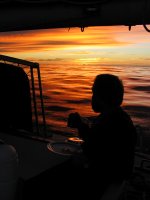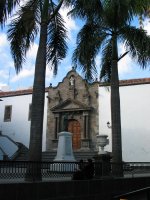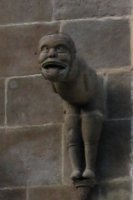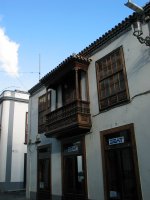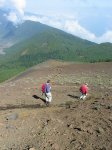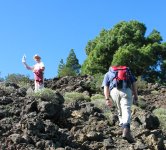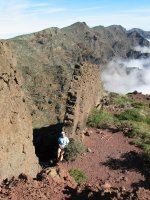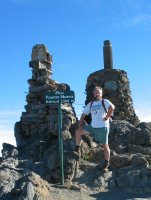 Canaries
- November 2003
Canaries
- November 2003
|
The passage from Porto Santo to the Island of La Palma in the Canaries only took three days but had plenty to keep us interested. The weather was mostly sunny and warm and winds were light. On the second day we were visited by a pod of about ten False Killer Whales - they are 4-5 metres long and are the biggest whales known to bow-ride, which they did with gusto!. They are dark grey and look a bit like killer whales (hence the name) but they have big bulbous noses which gives them a slightly comical look. |
|
While at sea, we have a simple watch system: from 9pm to 3am Tom sails and Sue sleeps and from 3am to 9am Sue sails and Tom sleeps. During the day we just do a bit of both and try to get another hour or so "siesta". During Tom's night watch on the same day as the False Killer whales, Tom noticed that something funny was happening with the moon. It was a beautiful clear sky with a full moon overhead (as your eyes adjust, it's almost like sailing in daylight). Over the course of the next hour and a half the moon slowly moved into the shadow of the earth - a lunar eclipse (8 November). As the moon disappeared, more and more stars appeared until there was a dull red moon and a sky-full of stars. Sue didn't mind being woken up for a look! |
Sundown. |
|
Next day we saw a pod of long-finned pilot whales, just lolling about on the surface, or "logging" as it's known (because they look like logs). These whales are a bit shy and move slowly, seemingly uninterested in us. |
|
Sunrise in the Canaries. |
Later that same day, we were visted by a large pod of common dolphins, up to their usual tricks, including a wee calf about 2 feet long with its mother. Next day, as the sun rose, we saw the islands of Tenerife, La Palma, La Gomera and El Hierro on the horizon ahead. |
|
As we approached Santa Cruz de La Palma, the main harbour, we were escorted by about a dozen small tuna. These fish obviously mistook us for a fishing boat and were waiting for fish guts. We tried fishing but they outsmarted us! |
Tuna escort. |
|
|
Santa Cruz de La Palma.. |
|
|
La Palma is one of the quieter Canary Islands and is the most recently volcanically active, the last eruption being in 1971. We spent over a week there and managed to get our boots on and walk over a few old volcanoes. While tied up in the harbour we got talking to a friendly German guy called Jurgen who stays on the island. He took us on our first volcano walk, Mount Birigoyo, and took us to the lava flow from an eruption in 1949. |
|
Mt. Birigoyo. |
|
|
|
1949 Lava Flow |
The 1949 eruption is interesting in that it caused a massive crack to appear on the southern ridge of the island. There is a theory that this will eventually result in a landslide into the sea of such huge size that the Tsunami will drown much of the east coast of America (search on La Palma Tsunami on the internet for details). |
|
We hired a car for three days to get more walking done. This included the 1971 volcano as well as the massive Caldera de Taburiente, high above the clouds at around 10,000 feet (the hire car did most of the climbing!). The views were spectacular. |
Caldera de Taburiente. |
|
Taburiente. |
Caldera of the San Antonio volcano which erupted in 1677. |
Altitude sickness. |
|
Our next island was La Gomera, even smaller and quieter than La Palma but a good place to prepare for the Atlantic crossing. We also managed to fit in another walk in the hills. Christopher Columbus had a house at San Sebastian on La Gomera which is still there and his crew said Mass in the church before sailing off in 1492. Although this is the location of the church, it's a bit like Trigger's broom (you have to have seen "Fools and Horses" to understand this!) in that it has been rebuilt several times since 1492!
|
|
The marina, La Gomera. |
|
The church in San Sebastian, La Gomera. |
|
We spent most of our time in La Gomera preparing Nechtan for the Atlantic crossing, loading fuel, water and food and checking our equipment, including replacement of our old autopilot.
|
Checking the weather forecast at an internet cafe. |
|
Another major equipment failure was the loss of our 2 big solar panels worth about £700. Their insides were "fried" when water got into the wiring and the ensuing short circuit caused the boat batteries to pump back into the panels, melting the little silver wires that connect each cell. "Oh bother!" we said to ourselves!! We were going to get a new panel over the internet, but delivery times meant we would be waiting here for ages. Electricity generation onboard is via: (1) when in a marina, connect to mains, (2) wind generator, (3) solar panels, (4) run the engine, but this is noisy and consumes diesel, (5) run our wee Honda generator, but this is also noisy and consumes petrol! Maybe in the Caribbean we'll find that Santa had a spare solar panel in his sack... So with everything ready, we left La Gomera on 4th December and headed south-west into the Atlantic. |
